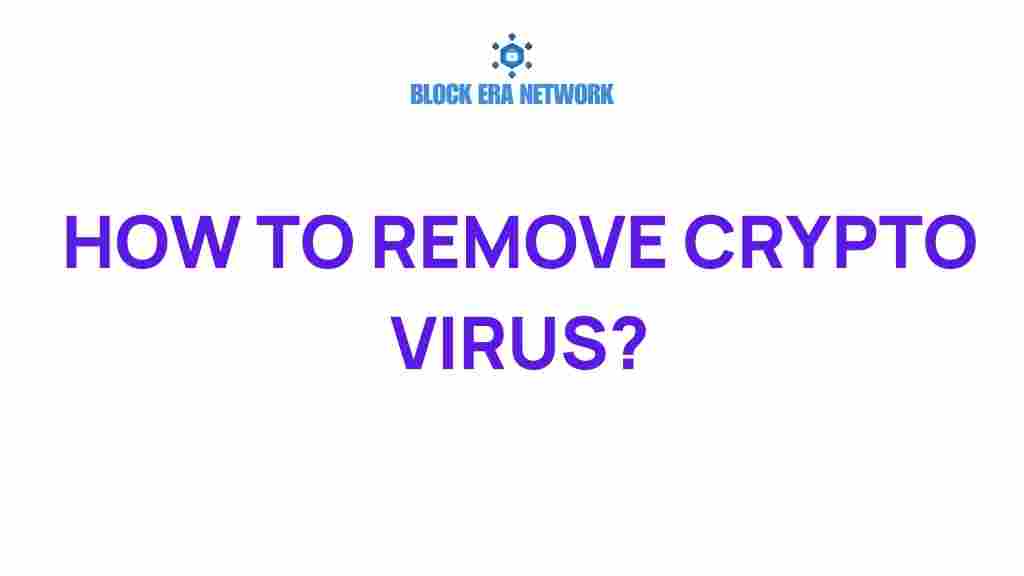Unmasking the Threat: How to Remove Crypto Viruses Safely
The rise of cryptocurrency has brought with it a new wave of cyber threats, including the notorious crypto virus. These malicious programs are designed to infiltrate your system, often resulting in the theft of your digital assets or hijacking your computer’s resources for illicit mining activities. In this comprehensive guide, we will delve into the world of crypto virus attacks, explore effective malware removal strategies, and discuss essential cybersecurity practices for ensuring your digital safety in a rapidly evolving landscape of online threats.
Understanding Crypto Viruses
Crypto viruses are a type of malware specifically targeting cryptocurrency users. They can manifest in various forms, including:
- Ransomware: Locks your files and demands payment in cryptocurrency to unlock them.
- Cryptojacking: Utilizes your computer’s resources to mine cryptocurrency without your consent.
- Phishing attacks: Tricks you into providing your private keys or login credentials.
With the increase in cryptocurrency popularity, the incidence of these attacks has also surged, making it imperative to understand how to protect yourself effectively.
Steps to Remove Crypto Viruses Safely
Removing a crypto virus from your system requires careful action to ensure you do not exacerbate the problem. Follow these steps for effective malware removal:
Step 1: Disconnect from the Internet
As soon as you suspect a crypto virus infection, disconnect your computer from the internet. This will help prevent the malware from communicating with its command and control server and stop any ongoing data theft.
Step 2: Boot into Safe Mode
Restart your computer and boot it into Safe Mode. This mode loads only the essential files and drivers, which can help prevent the crypto virus from running:
- For Windows: Press F8 during startup and select “Safe Mode with Networking”.
- For Mac: Hold the Shift key while booting up.
Step 3: Run a Full System Scan
Utilize reputable antivirus software to run a full system scan. This step is crucial for identifying and removing any malware, including crypto viruses. Here are some recommended antivirus programs:
- Malwarebytes
- Bitdefender
- Norton Antivirus
Make sure your antivirus definitions are up to date before performing the scan.
Step 4: Remove Detected Threats
Once the scan is complete, follow the software’s instructions to remove any detected threats. Ensure that you quarantine or delete any files associated with the crypto virus.
Step 5: Check for Unwanted Programs
After removing the malware, check your installed programs for anything suspicious. If you find software you do not recognize, uninstall it immediately. On Windows, you can do this via:
- Control Panel > Programs > Programs and Features.
Step 6: Update Your Operating System and Software
Keeping your operating system and software up to date is a critical step in virus prevention. Regular updates often patch security vulnerabilities that could be exploited by crypto viruses and other online threats.
Step 7: Change Your Passwords
After successfully removing the crypto virus, change your passwords for all accounts, especially those related to cryptocurrency. Use strong, unique passwords and consider enabling two-factor authentication for added security.
Step 8: Backup Your Data
Regular backups can mitigate data loss in future incidents. Utilize external hard drives or cloud services to ensure your data is safe and accessible in case of another attack.
Troubleshooting Tips for Malware Removal
Sometimes, the crypto virus may resist removal attempts. Here are some troubleshooting tips:
- Try Alternative Antivirus Software: If your current antivirus fails to detect or remove the malware, consider using another program.
- Use Malware Removal Tools: Tools like Malwarebytes can specifically target malware and provide additional cleaning capabilities.
- Check Browser Extensions: Some crypto viruses can install malicious browser extensions. Review and remove any that you do not recognize.
- Seek Professional Help: If you are still struggling to remove the virus, consider consulting a cybersecurity expert.
Enhancing Your Computer Security
Prevention is key when it comes to cybersecurity. Here are some proactive steps you can take to enhance your computer’s security:
- Install a Firewall: A firewall can help block unauthorized access to your computer.
- Enable Automatic Updates: Ensure your operating system and applications are set to update automatically to reduce vulnerability.
- Educate Yourself on Phishing Attacks: Be cautious of emails or messages asking for personal information, especially those related to cryptocurrency.
- Use a Virtual Private Network (VPN): A VPN can help protect your online activities from prying eyes and reduce the risk of data interception.
Conclusion
The threat of crypto viruses is real and growing. By understanding how these malicious programs operate and taking appropriate action for malware removal, you can protect your digital assets and maintain your computer security. Remember, virus prevention is an ongoing process that requires vigilance and proactive measures. Stay informed about online threats and invest time in securing your digital safety.
For more tips on enhancing your cybersecurity, visit our Cybersecurity Resources.
This article is in the category Crypto Security and created by Block Era Network Team

2 thoughts on “Unmasking the Threat: How to Remove Crypto Viruses Safely”